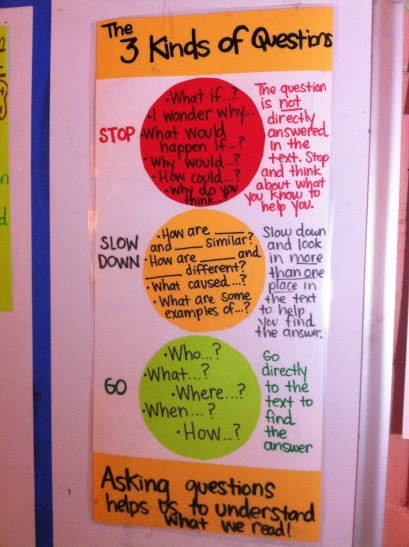Ever had one of these days?
If so, check out this article by Steve Reinhart (2000): “Never Say Anything a Kid Can Say!”.
For any fellow teacher-educators who view this, here's the home workshop I used to scaffold the discussion of this article, plus a few highlights from my students' post-workshop reflections.
Workshop: “Never say anything a kid can
say!”
Name:
Goal:
TLW explore how asking
questions can support learning.
Activate
Schema:
1.
You will read an article about questioning. Here’s a paraphrased
quote from the opening paragraph:
After
a great deal of planning, I presented a masterpiece of a lesson. I worked examples, I answered every question
in great detail, and I explained the concepts so clearly that surely every
student understood.
a.
Who was doing most of the thinking in the lesson? Is that a good
thing? Why or why not?
b.
The next sentence in the article reads: “The next day, it became
obvious: my students were totally confused.” Does that surprise you? Why or why
not?
Focus:
The ideas in the following chart are from a blog called “The Joy
of Literacy”:
Type
of thinking
|
Student
action
|
Examples
|
||
“STOP”
questions
|
Inferential
|
Stop and
think about what you know
|
What if..,
I wonder why..,
What would
happen if.., Why would..,
How
could.., Why do you think..?
|
|
“SLOW
DOWN” questions
|
Complex
|
Slow down,
look in more than one place, explore connections
|
How are..
and.. similar?
What
caused..?
What are
some examples of..?
|
|
“GO”
questions
|
Literal
|
Go directly
to the text to find the answer
|
Who, what,
where, when, how?
|
2.
Which type of question do find easiest? Which do you find most difficult?
Why do you think that is?
Activity: Read the
article: “Never Say Anything a Kid Can Say!” by Reinhart (2000) at bit.ly/1qm4BHZ and
then answer the following questions. As you read, highlight things that you want to remember or learn
more about.
3.
(GO)
How does
the author define what he means by a “good question”?
a.
(SLOW DOWN) What are some of the small changes the author
says he implemented over time?
b.
(STOP) Why
do you think the teacher’s questioning strategies might enhance student
learning?
4.
Create 3 new questions that get at important
information in the article and answer them. You will have an opportunity to
share your questions at our next meeting.
Type
|
Your
question
|
Your answer
|
GO
|
||
SLOW DOWN
|
||
STOP
|
Reflect
and share: Three things I want to remember from the article “Never say
anything a kid can say” are…
1.
1.
2.
3.
Please post your #1 “thing to remember” to our Facebook group.
A few highlights from the students' reflections on Facebook:
- Remember to listen. While listening, a teacher is able to learn what the student does/doesn't know.
- Sometimes we see teaching as us always doing the talking and them listening but this article showed how it works the other way around.
- Patience is very important... Many students stop thinking if the teacher is consistently calling on the [quick thinkers] who always seem to have their hand up first. I remember in elementary school I had all the right abilities but my thinking process was not as fast, so I never got the opportunity to share my thoughts.
- I want to remember to have open questions that challenge the students!
- One thing I want to take with me is to be able to teach better each year.
- I love the idea of asking good open ended questions instead of saying if they got the answer right. I never thought about it before, but we do stop thinking after we have our answer.
- One thing was that by changing the way he addressed students, the teacher was able to change the students' involvement in the class.
- Use more process questions rather than product questions. Students need to reflect, analyze, and explain rather than go back in their memory and reproduce facts.



No comments:
Post a Comment